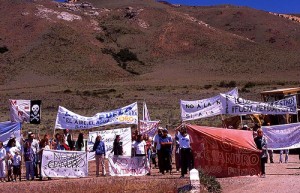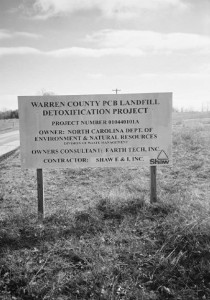
Buried within the depths of Andean geology lie small seams of gold tempting worldwide investors. These money-lined pockets aid the development of new extraction methods that dissolve gold from the mountains using cyanide. Cyanide is a metabolic poison, shutting down cellular respiration. In the wake of cyanide leaching stand piles of rubble and contaminated rivers where forested mountains and their people once stood. Surprisingly, Andean residents are willing to entertain the possibility of gold mining by this poisonous method, but oppose current mine development on environmental justice measures. A recent study by Urkidi and Walter in the journal Geoforum documents the emergence of justice narratives from mining conflicts in the Andes and predicts impacts on future development planning.

“Environmental injustice” was first described in Warren County, North Carolina in 1982 when largely African-American, rural, poor residents organized to oppose a polychlorinated biphenyl landfill near their farms and homes. Dubbed at the time ‘environmental racism’, the movement grew to fight the distributional injustices of pollution. Distributional justice refers to the unequal social, economic, and environmental impacts of a practice throughout society and is now recognized as an important dimension of environmental justice.
Environmental justice resonated with other disadvantaged communities who felt they were unfairly burdened with the environmental costs of modern society while financially incapable of acquiring the benefits. When the concept of environmental justice reached Latin America, it evolved through “articulation with a long tradition of human rights and social justice activism in the region”. This articulation of environmental justice in a global context created two dimensions of environmental justice that are dominant in the Andean mining cases examined in the study: recognition and participation.
“Recognition [is] the personal dignity of all individuals…but most importantly the recognition of collective identities and their particular needs, concerns, and livelihoods” the authors write. Anti-mining groups examined in the study united religious, farming, and political sectors, each feeling the importance of water to local people had not been recognized by the mine permitting process. They exposed that the mining company and Andean government failed to include glaciers, which provide drinking water and crop irrigation, in the environmental impact statement (EIS). Local residents “saw mining and their material and cultural subsistence as incompatible” and these subsistence needs were not recognized in the permitting process.
Participation, also known as “procedural justice…refers to the fair and equitable institutional processes of a State”. The permitting process included public meetings and a short comment period, but citizens were unsatisfied. They sued the government “for failing to respect their right of free and informed consent, for not considering the socioeconomic impact of the project on their traditional land-uses, and for not taking cultural impacts into account in the EIS assessment process”. Decisions occurred at a national scale, above the political access of local citizens, making the participation in name only.
Only at the end of the struggle did distributional justice, the original component of environmental justice, play a key role in the anti-mining movement. The fact that mining companies were based in Canada and the United States meant mining profits did not benefit local citizens, who would instead be left with piles of rubble and polluted streams. In one of the cases, this inequality translated into demands for nationalized mining to ensure benefits remain in the hands of the people who pay the environmental costs.
The authors conclude that three-dimensional environmental justice of fair distribution, recognition, and participation “no longer puts the focus on GDP growth, but switches the attention towards local definitions of wellbeing, where environmental, social, and economic needs are integrated”. Such a focus introduces the possibility of global and local sustainability.
Reference:
Urkidi, L., & Walter, M. (2011). Dimensions of environmental justice in anti-gold mining movements in Latin America Geoforum, 42 (6), 683-695 DOI: 10.1016/j.geoforum.2011.06.003
